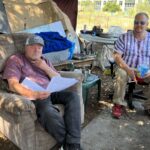In another David versus Goliath story, San Rafael is paying two outside law firms to defend the city against a lawsuit resulting from a restrictive homeless camping ordinance passed in July.
Residents of “Camp Integrity,” a homeless encampment on the Mahon Path in Central San Rafael, say they were compelled to file the legal action because the city’s ordinance violates their constitutional rights and places them in physical danger.
Last week, Senior U.S. District Court Judge Edward Chen extended a temporary restraining order against San Rafael, prohibiting the city from enforcing the new ordinance, which limits the size and number of homeless campsites in an area.
At the conclusion of the 90-minute hearing, Chen directed both sides to provide more information to the court before the next hearing on Oct. 2. Specifically, the federal judge wants briefings on whether San Rafael’s camping ordinance interferes with freedom of association, a protected right under the First Amendment, and the applicability of the state-created danger doctrine.
Chen also ordered the city to “produce a detailed legible map showing areas where camping is permitted (legible enough to see street boundaries) with an indication of the number of campers allowed in each area pursuant to the proposed density restrictions.”
The city’s hotly contested ordinance limits the size of a group campsite to 10 feet by 20 feet. An individual campsite can’t exceed 10 feet by 10 feet. All campsites must maintain at least 200 feet of separation—two-thirds the length of a football field.
Currently, about 40 people occupy 33 tents on half of the Mahon Path, from Lindaro Street to Lincoln Drive, an area measuring about 540 feet. Under the ordinance, only three campsites would be permitted in that space.
Some of the campers have disabilities and depend on their homeless neighbors to deliver necessary supplies, according to the lawsuit. Others, who have been the victims of sexual assault or domestic violence, rely on nearby campers for safety.
Chen questioned the city’s attorneys about the constraints that they claim will keep homeless people and the rest of the community safe.
“I don’t know what that number is—but couldn’t a larger cluster be accommodated so folks at least have enough in numbers that they feel safe, or they can count on somebody to help them with food and water?” Chen asked.
San Rafael’s attorney, Mark Austin of Burke Williams & Sorensen, referenced a staff report that “set forth all of the dangers of larger encampments.” Austin also pointed to the declaration of Lynn Murphy, a licensed therapist who works for the San Rafael Police Department as the mental health outreach liaison.
“When there’s three or more tents that get together and start to grow in terms of the trash, the crime, the biohazards, the fire risk, etcetera,” Austin said.
Chen then sought evidence for Austin’s assertion that when the homeless encampment population reaches a certain threshold, problems increase.
The city’s other attorney, Michael von Loewenfeldt of Wagstaffe, von Loewenfeldt, Busch & Radwick, jumped in to clarify.
“Your Honor, this is the city’s first attempt to limit density,” von Loewenfeldt said. “There’s no social experiment that’s been run where we count tents and measure problems…It’s not that we don’t want to answer your question; it’s just it’s hard to understand what it is you’re looking for, and it seems inconsistent entirely with the city’s legislative power, and this court’s very limited role in analyzing the constitutionality of ordinances like this.”
In other words, the city doesn’t believe their ordinance is a matter for the courts.
Anthony Prince, the attorney for the California Homeless Union, disagrees, maintaining that the ordinance isolates people. That isolation is the crux of the matters that Chen wants the parties to address. Does forcing homeless people into small groups with less than three tents prevent them from freely associating with one another? Is the city placing them in danger?
Homeless people need to associate for safety, sufficient access to services and community assistance, according to Prince.
Isolation creates more vulnerability, Prince asserted. Numerous studies back him up. Homeless people are far more likely to be victims of violent crime than housed people.
“Larger encampments tend to be safer,” Prince said.
Prince also pointed to a major benefit of large encampments—case managers know where to find their homeless clients and can keep them on a path toward permanent housing.
San Rafael has first-hand experience with the advantages of a large city-sanctioned encampment. From July 2021 through August 2022, the city operated a “service support area (SSA).” A staff status report, released in December 2021, touted the SSA’s success.
“It creates a central, designated place for our partners to provide services…Service providers have remarked to staff that the SSA allows them to reach more people and make greater impacts than if encampments were spread out over many locations.”
Ultimately, 35 of the 47 campers received permanent housing, according to Chris Hess, San Rafael’s assistant director of community development, housing and homelessness.
Yet, Austin, San Rafael’s attorney, provided the court with a much different account than the city’s own assessment.
“In fact, with respect to the case managers and other third-party service providers, they actually have a more difficult time in some instances accessing the homeless individuals at the larger encampments because they get harassed by some of the members of those encampments,” Austin opined. “And so, some of them avoid the encampments entirely.”
Lynn Murphy, the city’s mental health liaison, helped run San Rafael’s SSA. However, in her declaration to the court, she provided a similar, though milder version of Austin’s statement.
“Within the large encampments, the individuals living in the encampments are welcoming to the case managers, but it can often be intimidating for case managers to enter a site that is occupied by a large group of campers,” Murphy wrote.
After years of covering homelessness, I was unfamiliar with these intimidation and harassment claims. I contacted local nonprofits that employ case managers and outreach workers to determine whether they avoid homeless encampments.
“We always go into encampments,” said Chandra Alexandre, chief executive officer of Community Action Marin. “That’s our job. That’s what we do. Our people are trained for this kind of work, and they can go in pairs.”
Alexandre said that her staff has not reported feeling intimidated or harassed at the Mahon Path. Zoë Neil, director of Downtown Streets Team, concurs.
“Our case managers are in encampments all the time,” Neil said. “We do safety and de-escalation training, but I’ve had no reports that case managers are uncomfortable going into the Mahon Path or other San Rafael encampments. If we feel uncomfortable, we use the buddy system.”
Clearly, San Rafael and the homeless plaintiffs have a lot to work out. Chen arranged for the parties to engage in settlement talks beginning on Sept. 20. A rational solution, such as establishing a city-sanctioned encampment, will hopefully surface during those negotiations.
Otherwise, the city and its homeless residents will be bound by Chen’s next ruling, likely leaving one side unhappy. But for now, the campers will stay on the Mahon Path.


